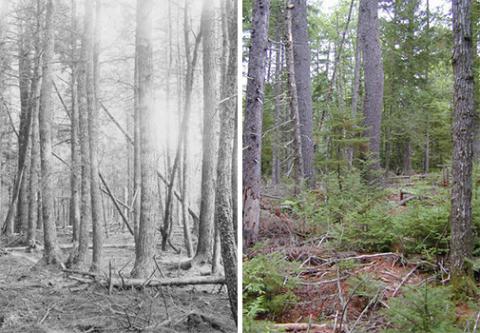Sustainable Northern Conifer Forest Management: New Findings and Outreach Tools

Long-term studies of forest response to harvesting can help foresters make management decisions to meet short- and long-term goals. The USDA Forest Service initiated the Compartment Management Study in the northern conifer forest of Maine’s Penobscot Experimental Forest (PEF) in 1952. While initial goals focused on sustainable timber production and income, data collected every 5 to 10 years since then give insight about outcomes like wildlife habitat, climate adaptability, and carbon storage.
Using this data, NSRC researchers examined the effects of over 65 years of even-aged (shelterwood) and uneven-aged (single-tree selection) silviculture and exploitive harvesting (diameter-limit cutting and other forms of high-grading) on tree growth, yield, and value, timber quality, species composition and diversity, carbon storage, wildlife habitat, and more. No one treatment met all objectives important to today’s forest managers. The shelterwood treatments most successfully controlled species composition and stand structure, but the relatively uniform stands may not be resilient to market or environmental changes. Selection treatments increased large, high-quality trees and more diverse habitat structures, but did not encourage species thought to be adaptable to climate change. Exploitive harvesting encouraged climate change-resilient species, like red maple, but led to low growth rates, tree quality, and stand value.
The PEF provides an opportunity to see these treatments side-by-side and communicate outcomes through photos, video, and data. Researchers created landowner-friendly communication tools, a 26-minute video, and glossy booklet to convey findings. By increasing awareness of long-term forest changes from harvesting, these results and communication tools help landowners and foresters make decisions that will increase resilience and sustainability of forests into the future.
